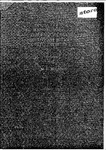The Microbiostratigraphy of the Paiaeocene of the Northwest European Continental Shelf
| dc.contributor.author | Bidgood, Michael Dominick | |
| dc.contributor.other | School of Geography, Earth and Environmental Sciences | en_US |
| dc.date.accessioned | 2012-08-01T14:08:42Z | |
| dc.date.available | 2012-08-01T14:08:42Z | |
| dc.date.issued | 1995 | |
| dc.identifier | Not available | en_US |
| dc.identifier.uri | http://hdl.handle.net/10026.1/1065 | |
| dc.description.abstract |
A total of 186 samples taken from 9.offshore Central & Southern North Sea boreholes, 1 onshore "XJK borehole, 2 onshore UK locahties and 2 onshore Danish' localities were processed and analysed for microfauna. A total of 273 individual taxa were identified- the majority to species level. The dommant microfaunal group recorded are the Foraminifera of which 23 genera were agglutmated, 75 calcareous benthonic and 21 planktonic. Other groups recorded are the Ostracoda which comprised 5 genera, Diatomacea 2 and Radiolaria 1. The recorded taxa are diagnosed and their stratigraphic and palaeoenvironmental significance discussed. The samples range in age from Late Cretaceous (Maastrichtian) through Paiaeocene (Danian & Thanetian) to Early Eocene (Ypresian) and occasionally Middle Eocene (Lutetian). The offshore boreholes are biostratigraphically zoned with respect to the published biozonation scheme of King, 1989, and the so-called "bioevents" (i.e. microfossil marker horizons) described by Mudge & Copestake, 1992. The emphasis of the study was placed on the stratigraphical distribution of the microfaunas, particularly in the offshore realm where the majority of the boreholes (7) are located in the Southern North Sea area (Quadrants 44 and 49); a region lacking in previously published research on microfaunas of this age. The biozonation scheme of King, 1989, is found to be broadly applicable to all of the boreholes studied although some dififerences m detail were noted. Not all of the bioevents of Mudge & Copestake (1992) are recorded. The samples studied are insuflBciently closely spaced to permit the construction here of a separate biozonation scheme, specific to the Southern North Sea area, although it is considered that the future creation of such a scheme could be justified with additional data. A total of 53 individual microfossil marker horizons thought to have stratigraphic utility in the area are noted. The bulk of the Paiaeocene sediments deposited in the Southern North Sea area were laid down under moderate palaeodepths (c. middle shelf) and probably representative of the socalled "outer sublittoral" biofacies of King, 1983. Evidence for progressive deepening of water depth towards the north of the area and mto the Silver Pit Basin was noted. The microfaunal assemblages from the offshore boreholes are similar in overall character to microfaunas recorded from onshore Palaeogene sections in the UK and Denmark. | en_US |
| dc.description.sponsorship | Department of Geological Sciences; SheU (U.K.) Exploration & Production Ltd | en_US |
| dc.language.iso | en | en_US |
| dc.publisher | University of Plymouth | en_US |
| dc.title | The Microbiostratigraphy of the Paiaeocene of the Northwest European Continental Shelf | en_US |
| dc.type | Thesis | en_US |
| dc.identifier.doi | http://dx.doi.org/10.24382/1330 | |
| dc.identifier.doi | http://dx.doi.org/10.24382/1330 |
Files in this item
This item appears in the following Collection(s)
-
01 Research Theses Main Collection
Research Theses Main


